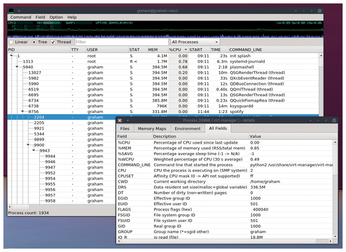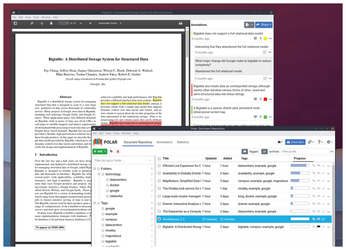FOSSPicks
qps
Process managers have been around for as long as computers could run more than one process. We don't often think about them. The humble ps command is often hidden away behind a pipe and a grep, and top or htop are used when you need something more interactive. On the desktop, all the major environments include their own process managers, so there seems very little reason to use anything else. But what if one desktop's tool does a better job than others? That's exactly what happened with LXQt's qps, which can be built separately without needing any other parts of the LXQt desktop. It's great to see that developers are still creating alternatives and new ways of looking at the same data, which is exactly what qps, a Qt process manager, does, albeit with a Qt-based GUI.
On the surface, qps looks a lot like the output from the top command, encapsulated within a GUI. CPU, memory, and swap usage meters are shown at the top with the list of running processes shown below. This list can be formatted as a tree and also show threads; you can click on columns to sort by user, memory usage, CPU, and time. The great thing about doing all this from a GUI is that you don't need to remember the key commands for the function, as everything is just point and click. If you double-click a process another pane appears – this time showing more in-depth details about a particular process. These include the files and sockets being accessed by a process, memory maps and offsets for the libraries being used. Another useful tab in this pane shows a list of all the environment variables accessible to the process, which is a great way of troubleshooting problematic processes or applications, especially when they're being run from user accounts other than your own.
Project Website
 Processes can also be listed as threads and trees, which helps when you don't know which has spawned what.
Processes can also be listed as threads and trees, which helps when you don't know which has spawned what.
Text manager
Polar
We probably read more words now than at any other point in history, and it's a pity that we don't collect and curate words in the way libraries do. This is obviously because most of our reading is from the Internet, and consequently, transitory and disposable. But not everything online is like that, and Polar is a tool that can help with reading organization and curation. It's especially helpful when you're conducting any kind of research or study, because it's likely that your data store would become a mish-mash of notes, annotations, printouts, and PDFs, with nothing to group them together effectively or track your work. These are all problems that Polar hopes to solve.
Polar is an application designed to help you store online files offline, manage those files, add your own notes and annotations, and sync your entire library with an optional online account. It can deal with PDFs and ePubs, documents can be tags and organized into folders, and Polar lets you add annotations anywhere and export these as Markdown for your own notes. There's a wonderful Statistics tab that gives you an overview of everything you've done and when; it feels very much like GitHub's activity tracker for developers. If you're working on a thesis or studying a complex subject, this kind of oversight is invaluable if you need to read through an entire body of work. But even those of us with more modest requirements will find Polar useful. The document reader with its progress bar and integrated annotation is clear and useful even for casual reading. Its focus is always on the value of incremental reading. Having an application that tracks reading like this – rather than a collection like Calibre – is a refreshingly different approach to reading even online documentation.
Project Website
Buy this article as PDF
(incl. VAT)
Buy Linux Magazine
Subscribe to our Linux Newsletters
Find Linux and Open Source Jobs
Subscribe to our ADMIN Newsletters
Support Our Work
Linux Magazine content is made possible with support from readers like you. Please consider contributing when you’ve found an article to be beneficial.

News
-
XZ Gets the All-Clear
The back door xz vulnerability has been officially reverted for Fedora 40 and versions 38 and 39 were never affected.
-
Canonical Collaborates with Qualcomm on New Venture
This new joint effort is geared toward bringing Ubuntu and Ubuntu Core to Qualcomm-powered devices.
-
Kodi 21.0 Open-Source Entertainment Hub Released
After a year of development, the award-winning Kodi cross-platform, media center software is now available with many new additions and improvements.
-
Linux Usage Increases in Two Key Areas
If market share is your thing, you'll be happy to know that Linux is on the rise in two areas that, if they keep climbing, could have serious meaning for Linux's future.
-
Vulnerability Discovered in xz Libraries
An urgent alert for Fedora 40 has been posted and users should pay attention.
-
Canonical Bumps LTS Support to 12 years
If you're worried that your Ubuntu LTS release won't be supported long enough to last, Canonical has a surprise for you in the form of 12 years of security coverage.
-
Fedora 40 Beta Released Soon
With the official release of Fedora 40 coming in April, it's almost time to download the beta and see what's new.
-
New Pentesting Distribution to Compete with Kali Linux
SnoopGod is now available for your testing needs
-
Juno Computers Launches Another Linux Laptop
If you're looking for a powerhouse laptop that runs Ubuntu, the Juno Computers Neptune 17 v6 should be on your radar.
-
ZorinOS 17.1 Released, Includes Improved Windows App Support
If you need or desire to run Windows applications on Linux, there's one distribution intent on making that easier for you and its new release further improves that feature.


